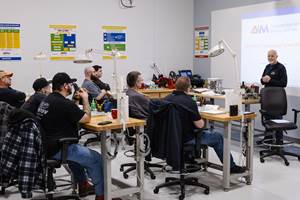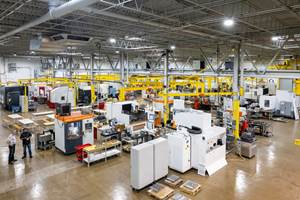A Shirt of a Different Color
In today’s tool shop facilities it is apparent that a communication/teamwork chasm still exists, which must be addressed in order to improve operations.
I loved my job. We had 15 full-time unionized mold repair technicians and more than 600 active high cavitation molds shuttling in and out of 55 presses at a MPP (mold pull pace) hovering around five to eight per day. This was more than enough work to keep us blue-shirts flush with all the overtime hours that we could handle.
We worked on a mold as long as we wanted (called milking) and management pretty much stayed out of the shop for fear of being asked one of the following questions: “What should I do now, boss?” or “Do you know a better way?”
Covert Maintenance
But the best part of our job was in a complete lack of accountability for what we did. A log book documentation plan coupled with three shifts running around the clock allowed plenty of excuses why a mold did not start up or run as intended.
Knowing that no one in the plant had a clue as to what we should or should not be doing any time of the day or stage of repair, a mold repair tech could—without raising much suspicion—visit just about every department in the plant.
Trips to molding (checking on my mold), assembly (making sure the parts aren’t jamming the feed track), front office (hey, my badge just quit working), and the warehouse (I’m looking for some sample parts) when things got boring in the toolroom were a common occurrence. The trick was to keep a rag in your hands and don’t stand in one place too long.
Old habits die hard when it comes to maintenance cultures and as I continue to hear from toolmakers, repair technicians and the management personnel who really want to improve operations, it is apparent that a communication/teamwork chasm still exists in many companies, so a little blue-shirt insight here is appropriate.
Color-Blind Could Be a Good Thing
This profit-eroding bias sustains through differing backgrounds, experiences, agendas and unfortunately in many cases, the color of our shirt. One would think that being on the same team with like goals would foster more of a vehicle for blue-white commonality to pull together as a team to better navigate the challenges of manufacturing success, but this is not always the case.
And although not my particular style, it makes sense that the Japanese mandate that everyone in the plant wear the same type of uniform. With this dress code, one needs to earn the bonehead moniker…instead of it being automatically associated with the color of your shirt.
Maintenance personalities remain basi-cally unchanged over the years with one glaring difference—everyone feels the enormous pressure of offshore competition. The added anxiety of watching jobs disap-pear overnight seems to exacerbate already delicate relationships between not only salary and hourly, but interdepartmental issues between toolroom and processing. It seems we get so wrapped up with our seat on the bus that we forget where the bus is going and what it needs to get there.
It takes a sharp management group that knows where, when and how to hire, motivate, train, discipline and direct a team of experienced, skilled, tenured, opinionated, moody, proud and competitive veteran tradesmen, who make their living the old-fashioned way: combining tools and a knowledge of the practical applications of their specific trade.
And now, with the above group of workers heading into their golden years, you also need to include a younger, energetic, better educated, inexperienced, coddled and undisciplined worker into your maintenance metrics.
Trading Spaces and Shirts
Leaving the familiarity and security of my work bench to take a new job in a tooling engineering field was an opportunity that was both exciting and at first, quite awkward. I was worried that too much blue-shirt background might bias difficult decisions that would be required to make a much needed culture change in the union atmosphere into which I was heading. Fitting in wouldn’t be the problem until the boat gets rocked while balancing friendship and aggressively pursing job responsibilities.
So it seemed like a smart idea to “good-ole-boy” my way around the new shop and attempt to get things done through the buddy system. But all that got me was a couple of buddies, no real improvement or accomplishments. So once I began to move some serious cheese around through implementation of a new documentation system, my popularity took a severe hit, for even my two new buddies were not comfortable being accountable for work they performed.
Also discomforting was recognizing that I had come full circle, and that many of our old shop traits were now issues that I had to deal with—kind of like watching yourself turn into your parents. The next seven years was spent getting used to a new shirt while working with a group of repair techs and putting into practice a few unwritten “codes of conduct” that I believe are worth sharing.
Codes of Conduct
These codes are based on a combination of experience, e-mails and conversations with many shirts of different colors, that you probably won’t find in the typical “How to make friends and influence people” type literature. But in the real world of maintenance ignoring a few of these will only further widen the gap between shirts and greatly hinder company success and prosperity.
For Salary Folks Don’t:
- Openly ridicule someone’s lack of skill or oversight. Public floggings, even if warranted will not result in the white shirt (flogger) increasing their respect factor—a much needed attribute to effectively managing and motivating in a maintenance environment. Take it to the office.
- Assume that someone’s name is on their shirt because they can’t remember it.
- Hover over work being performed with your arms crossed like it won’t get done right unless you are there to manage it correctly.
- Whistle someone over to you, save that for your dog.
- Nick-pick the clock. If you tap your watch and frown while work is being done to save a few minutes, it will end up costing you hours.
- Throw your arms up in the air and emphatically proclaim to “just get it done” without understanding all the issues.
- Assume that a repair tech reviewing the mold manual is just screwing off.
- Stifle creativity by dismissing an idea, such as a jig, fixture or a new procedure as stupid or a waste of your time.
- Tell repair personnel the cost of a mold or tooling, or other aspects of maintaining molds or improving shop efficiency is privileged information.
- Run up front with someone’s good idea and proclaim that it is yours.
For Hourly Folks Don’t:
- Be unprofessional in your appearance and conduct. Being the grimiest, loudest, most obnoxious or crudest won’t score any points with anybody.
- Deliver bad news to the boss with a smile on your face. What is so funny about a manifold being flashed for the third time in a row?
- Assume the pondering position for so long your handprints remain on your face for over an hour.
- Stand around in groups chatting about American jobs going overseas.
- Fling tools across the shop when you are upset and control the desire to smash something together that just doesn’t fit like it should.
- Stand and watch someone struggle with a mold and not offer to lend a hand.
- Hoard information that could help someone fix a mold just to be the man.
- Be the shop prankster (greasing ma-chine handles, hiding tools, gluing things together, being destructive or disruptive).
- Be dangerous to work around.
- Be the one to always take a mold apart, but never around to put it back together.
Everyone brings something to the table. Regardless of what color shirt is worn, that person adds value to the company and it is our job as team players to understand the different roles and to mesh smoothly and effectively to ensure long-term company survival.
Related Content
Mold Maintenance Continues to Matter: Enhanced Training Program in a New Facility
I attended a MoldTrax mold maintenance workshop in 2019 and shared my experiences, and despite changes in ownership, the workshop's remarkable value endures, as discussed in a recent Q&A with the current leadership.
Read MoreHow to Foster Innovation Through a Culture of Education, Mentoring
Dynamic Tool Corp. shares its strategy for building a team with the right attitude and aptitude to deliver innovation that meets customer expectations.
Read MoreCross Training, In-House Capabilities and Collaborative Design Move Helm Tool Forward
Cross-training, bringing it all in-house, molding and collaborative design are essential to Helm Tool's success.
Read MoreHands-on Workshop Teaches Mold Maintenance Process
Intensive workshop teaches the process of mold maintenance to help put an end to the firefighting culture of many toolrooms.
Read MoreRead Next
How to Use Strategic Planning Tools, Data to Manage the Human Side of Business
Q&A with Marion Wells, MMT EAB member and founder of Human Asset Management.
Read More

















